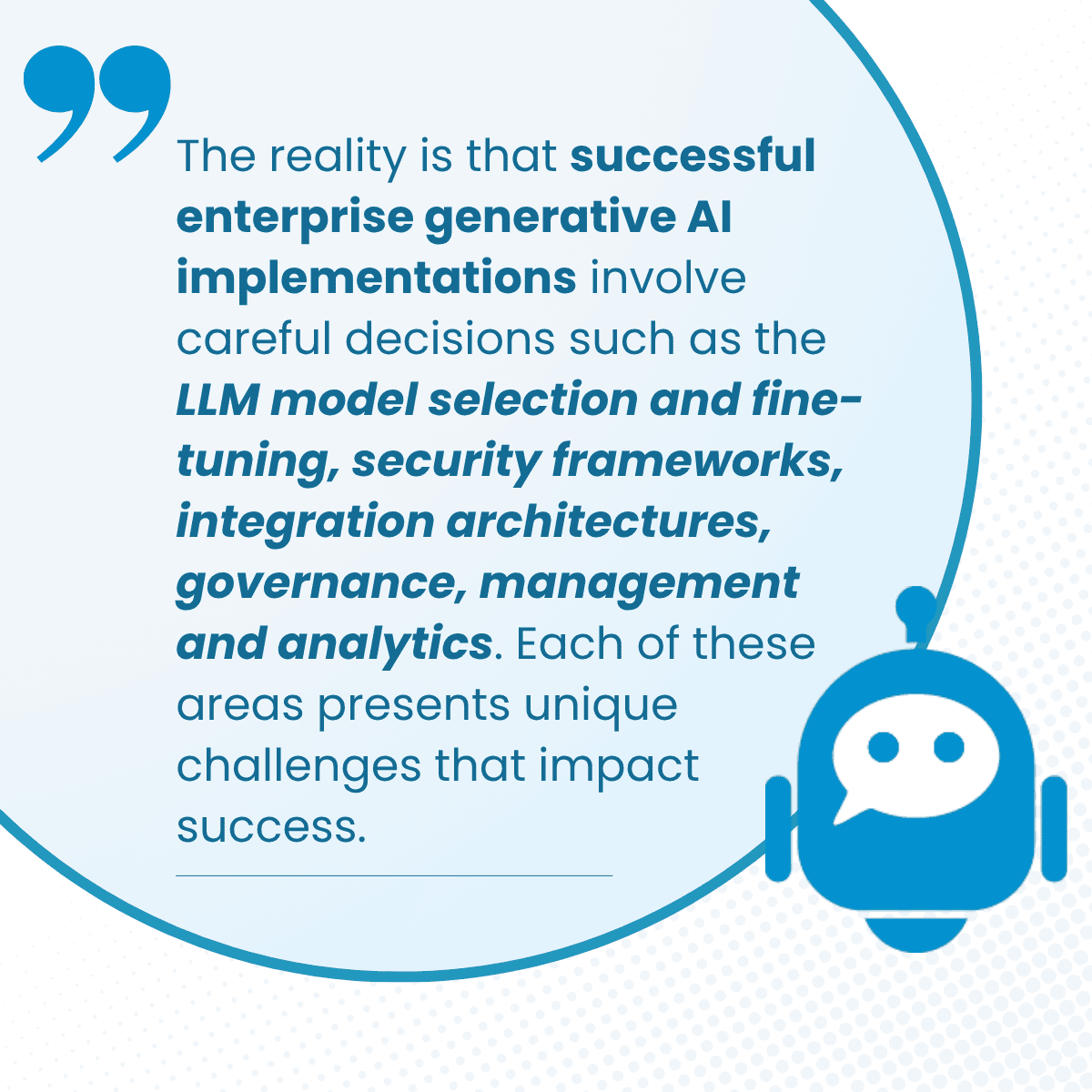AI, Large Language Model
Crafting an RFP that drives Successful Generative AI Initiatives
Succeeding with Generative AI starts with asking the right questions.
The stakes for LLM-based and Generative AI implementations are high and executives across banking, insurance, mortgage, healthcare, and other regulated industries are faced with a crowded landscape of AI vendors—all in a rapidly changing technology landscape.
Organizations that get their generative AI vendor selection right can benefit from productivity gains, improved customer experiences, and more competitiveness. Those that rush their procurement process may risk costly implementations, potential security and compliance vulnerabilities, and projects that fail to get off the ground or lack scalability.
Thoughtful consideration when planning Generative AI implementations and a carefully crafted Request for Proposal (RFP) can be the make or break for successful AI projects.
But what questions comprise a comprehensive and well-considered RFP?
How can you separate genuine capability from hype when evaluating a vast landscape of AI providers?
The more comprehensive your RFP is, the better your chances are of procuring the right AI vendor and technology solution to meet your business’s needs for LLM-based solutions.
As we see an increasing number of businesses issuing RFPs for generative AI and LLM solutions, it struck us that it would be helpful to create a detailed RFP template that guides the crafting and structure of the questions that test AI vendor products and capabilities..
The Complexity of AI Solutions and the Problem of Oversimplification
At first glance, generative AI might seem straightforward—plug in an API, add some prompts, and watch the magic happen. This perception has led to a dangerous oversimplification in how enterprises approach generative AI solutions.
The reality is that successful enterprise generative AI implementations involve careful decisions such as the LLM model selection and fine-tuning, security frameworks, integration architectures, governance, management and analytics. Each of these areas presents unique challenges that impact success.
For organizations in financial services, healthcare, and other regulated sectors, the stakes are even higher. These industries must navigate not only technical complexity but also strict compliance, data governance, and risk management requirements that are best suited to experienced AI vendors with a suitable track record.
Traditional software procurement approaches are inadequate in the realm of generative AI and LLMs as they don’t account for the unique characteristics of AI systems— e.g. potential for hallucinations, need for continuous monitoring, the pace of LLM advancements, and the importance of explainability and audit trails.
The Strategic Advantage of Thoughtful RFP Template for Generative AI Solutions
A well-structured RFP template for generative AI is not only about AI vendor selection. It forces internal agreement on use cases and success metrics, identifies potential integration challenges, identifies security and compliance requirements from the outset, and creates a framework for ongoing vendor accountability and performance measurement.
Here are the critical areas that a well-crafted RFP should address.
Use Case Validation and Business Impact
The RFP should require vendors to demonstrate specific understanding of your industry’s challenges and regulatory environment. Understand how the vendor’s platform or product handles edge cases, workflows, and the complexity of enterprise data.
Technology Architecture and Integration Reality
Some AI vendors struggle with enterprise integration requirements. The RFP should explore infrastructure requirements, API limitations, data flow architectures, and the practical challenges of connecting AI capabilities to existing enterprise systems.
Security and Compliance Framework
For regulated industries, security is table stakes. The RFP should evaluate not just current security practices but also the vendor’s understanding of your specific regulatory environment. How do they handle data residency requirements? What audit capabilities do they provide? How do they ensure model outputs meet compliance standards?
Model Flexibility and Lifecycle Management
The AI landscape evolves rapidly, and your chosen platform must evolve with it. Evaluate vendors’ approaches to model selection, version management, fine-tuning capabilities, and their roadmap for incorporating new AI developments. Avoid vendors that lock you into specific models and look for those that support multiple LLMs and flexible model integration.
Operational Excellence and Support
Enterprise AI implementations require ongoing support that goes far beyond traditional software support models. The RFP should evaluate vendors’ implementation methodologies, change management capabilities, training programs, and long-term success frameworks. How do they handle model drift? What analytics do they provide for ongoing optimization?
Our RFP Template for Evaluating Enterprise Generative AI Solutions & Vendors
Is your organization eager to harness the power of Generative AI and LLMs with a successful AI partner who can help you integrate, scale, and manage these solutions effectively? If the answer is yes, then you may want to start with asking the right questions.
Our newly released Enterprise RFP Template for Generative AI Implementations offers a comprehensive set of questions to guide your evaluation across critical areas — from use cases and security to integration, LLM selection, fine-tuning, analytics, and beyond.
This template provides a strategic advantage — it goes beyond checkboxes to help you surface meaningful vendor differences and maintain control over your generative AI journey. Our format offers you a:
- Fully editable spreadsheet format (upon request),
- Covering the full lifecycle — from model selection to analytics,
- Designed for leaders in Business, IT, Procurement, Product, and Transformation
If you would like to download the full RFP template comprising over 125 fully editable questions in spreadsheet format please email info@servisbot.com
For a free preview take a look at our mini version of the RFP template.
